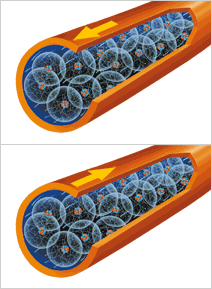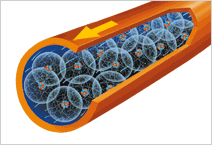Direct Current and Alternating Current
 In alternating current, the electrons move in both directions.
In alternating current, the electrons move in both directions.

In direct current, the electrons always move in the same direction.
Alternating current
When the movement of electrons is caused by a magnet traveling inside a coil of metal wire, it’s said to be of electromagnetic origin. Actually, the electrons move back and forth between the atoms, as the magnet alternately pushes and pulls them. This type of current is called alternating current. Magnetism is used to generate over 99% of the world’s electricity.
In alternating current, the electrons move in both directions because they are influenced alternately by the north and south poles of a magnet. In fact, alternating current changes direction 120 times per second!
The rise and dominance of alternating current
For transmitting power, alternating current is more effective than direct current. But this was not always the case. Just over 100 years ago, they were rival technologies. Alternating current supporters included George Westinghouse, while Thomas Edison was among those backing direct current. This was the dawning of the age of electricity and American industrialists were seeking the best and cheapest way to bring this new energy from power stations to manufacturing plants. In 1887, Nikola Tesla bolstered the cause for alternating current by developing the first practical system for generating and transmitting alternating current.
Direct current
Electricity of electrochemical origin is generated through a chemical reaction that triggers a movement of electrons in one direction inside the conductor: for example, from the negative to the positive terminal of a battery. This type of current is called direct current.


